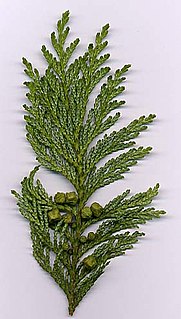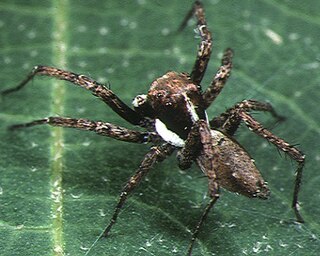
Jumping spiders or the Salticidae are a family of spiders. As of 2019, it contained over 600 described genera and over 6000 described species, making it the largest family of spiders at 13% of all species. Jumping spiders have some of the best vision among arthropods and use it in courtship, hunting, and navigation. Although they normally move unobtrusively and fairly slowly, most species are capable of very agile jumps, notably when hunting, but sometimes in response to sudden threats or crossing long gaps. Both their book lungs and tracheal system are well-developed, and they use both systems. Jumping spiders are generally recognized by their eye pattern. All jumping spiders have four pairs of eyes, with the anterior median pair being particularly large.

Chamaecyparis, common names cypress or false cypress, is a genus of conifers in the cypress family Cupressaceae, native to eastern Asia and to the western and eastern margins of the United States. The name is derived from the Greek khamai (χαμαί), meaning "on the earth", and kuparissos (κυπάρισσος) for "cypress".

Portia is a genus of jumping spider that feeds on other spiders. They are remarkable for their intelligent hunting behaviour, which suggests that they are capable of learning and problem solving, traits normally attributed to much larger animals.

Chinattus is a genus of jumping spiders that was first described by D. V. Logunov in 1999. The name is a combination of "China" and -attus, a common suffix for salticid genera.
Dexippus is a genus of Asian jumping spiders that was first described by Tamerlan Thorell in 1891. As of June 2019 it contains only three species, found only in Asia: D. kleini, D. taiwanensis, and D. topali. The name is derived from Publius Herennius Dexippus, an ancient Greek historian.

Pancorius is a genus of Asian jumping spiders that was first described by Eugène Louis Simon in 1902. They are similar to Hyllus.
Chinophrys wuae is a species of jumping spider, named after the collector Hai-Yin Wu. C. wuae is similar to Attulus penicillatus, and is only known from Taiwan.
Dexippus taiwanensis is a jumping spider, similar in appearance to D. kleini. It is endemic to Taiwan, which provides its specific epithet "taiwanensis".

Macrothele is a genus of mygalomorph spiders in the family Macrothelidae, and was first described by A. Ausserer in 1871. It is the only genus in the family Macrothelidae, and most species occur in Asia, from India to Japan, and Java, with four found in Africa, and two in Europe. The name is derived from Ancient Greek μακρός ("makro-"), meaning "big", and θηλή ("thele"), referring to the spinnerets.

Pinus taiwanensis, the Taiwan red pine, is a species of conifer in the family Pinaceae. It is found only in Taiwan. It is a close relative of Pinus luchuensis of Japan and Pinus hwangshanensis of China, sometimes considered as a subspecies of the former. Sometimes Pinus hwangshanensis from China are also referred to as P. taiwanensis.

Chamaecyparis taiwanensis is a species of cypress, native to the mountains of Taiwan, where it grows at altitudes of 1300–2800 m.
Chinattus taiwanensis is a species of jumping spider found exclusively in Taiwan.
Pancorius taiwanensis is a species of jumping spiders found only in Taiwan. It is a tiny spider with a total length of only 2.25 millimetres (0.089 in). The densely hairy carapace is dark brown with a large pale, roughly triangular patch centrally. The legs are dark brown with large, prominent spines. The oval abdomen is grey with darker and lighter striations with paler patches on each side at the front.
M. taiwanensis may refer to:
Carmentina taiwanensis is a species of sedge moths in the genus Carmentina. It was described by Yutaka Arita and John B. Heppner in 1992. It is found in Taiwan.

The sharp-nose garden eel is an eel in the family Congridae. It was described by Shao Kwang-Tsao in 1990. It is a marine, subtropical eel which is known from Taiwan and southern Japan, in the northwestern Pacific Ocean. It is non-migratory, and dwells at a depth range of 14 to 22 metres. Males can reach a maximum total length of 74.1 centimetres (29.2 in). It can be identified by the shape of its snout.
Gavialiceps taiwanensis is an eel in the family Muraenesocidae. It was described by Johnson T. F. Chen and Herman Ting-Chen Weng in 1967, originally under the genus Chlopsis. It is a marine, deep water-dwelling eel which is known from the northwestern Pacific Ocean, including Taiwan and Okinawa, Japan. It dwells at a depth range of 600 to 750 metres. Males can reach a maximum total length of 75.7 centimetres (29.8 in).

Gnathopalystes is a genus of huntsman spiders that was first described by William Joseph Rainbow in 1899.
Sympenchelys taiwanensis, also known as the Taiwanese worm eel is a species of ophichthid fish found in Taiwan. This species is only known from northeastern and southwestern Taiwan. This species is the only member of its genus.
Chinophrys is a genus of jumping spiders that was first described by J. X. Zhang & Wayne Paul Maddison in 2012.









